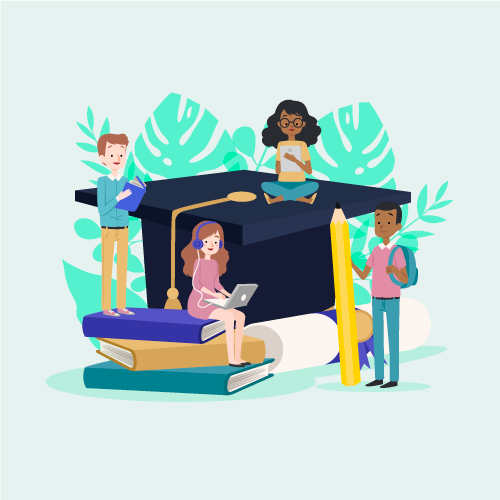The Universal Design for Learning (UDL) is a framework that creates educational experiences accessible and beneficial to learners of different abilities at all levels of education. This includes students from K-12 to higher education, skill training, workplace, healthcare training, and community programs.
UDL ensures that learning materials, multimedia content, engagements, activities, and assessments are inclusive by accommodating different learning styles and unique learner preferences.
The UDL framework is created by the Center for Applied Special Technology (CAST), a nonprofit organization that works with education research and development. These guidelines help make educational methods inclusive and accessible for people of all abilities and learning styles. The 3 principles of Universal Design for Learning are:
- Multiple means of representation.
- Multiple means of action and expression.
- Multiple means of engagement.
These guidelines help educators create effective learning environments that cater to the diverse needs of all learners. Here’s a closer look at the 3 principles and their 9 core guidelines:
Multiple means of representation:
Explores how to design a curriculum to help students understand what they are learning by tapping into the recognition network of their brains. The end goal of Multiple means of representation is to make learners resourceful & knowledgeable.
- The first guideline, Provide Options for Perception, is to provide options for perception. This ensures that all information is perceptible to all learners based on their abilities and preferences. Educators should provide ways to let learners customize the display of information and present every important information in different forms such as alternatives for auditory and visual content.
- The second guideline, Provide Options for Language & Symbols, is to provide options to help learners comprehend language and symbols by clarifying vocabulary, and symbols, and providing alternatives to understand syntax and structure between elements and diagrams. This also includes helping learners understand mathematical notation, and symbols while providing translations and offering the content through multiple media formats.
- The third guideline, Provide Options for Comprehension, ensure that learners of all abilities have comprehended the information. Educators must supply background knowledge, guide learners to process and visualize information in formats that learners of different abilities can comprehend, and help learners apply these lessons to new contexts in the future.
2. Multiple means of action & expression:
The second principle accesses the strategic network of the brain and explores the “HOW” of learning. The motive of Multiple means of action & expression is to make learners strategic and goal-oriented.
- The fourth guideline in the universal design framework, Provide Options for Physical Action, is to make physical interaction by the learner accessible by providing multiple options. Educators must provide material that is useable by different abilities. For example, a textbook should also be available as an ebook, physical activities and assessments must have alternative interaction methods that can be navigated via the keyboard, screen readers, switch inputs, and other assistive technologies.
- The fifth guideline, Provide Options for Expression & Communication, focuses on providing multiple methods and technologies for expression and communication. A learner should be able to express their ideas and learnings on the same level as the rest of their peers using the medium that is most accessible and comfortable to them. This includes the use of multi-media technologies for interacting, assistive technologies, study aids, text-to-speech applications, audio recording, and much more.
- The sixth guideline, Provide Options for Executive Functions, helps learners with their executive functions. Aiding learners set their own goals that are challenging and yet realistic based on their abilities, supporting their plan building and strategies based on their physical and cognitive abilities by providing extra coaching for goal setting, understanding organizational strategies, and self-evaluation, templates, and guides to help break their larger tasks.
3. Multiple means of engagement:
The third principle of the Universal Design for Learning framework taps the affective Networks of the brain, that is the “WHY” of learning. The goal of Multiple means of engagement is to make learners motivated.
- The seventh guideline, Provide Options for Recruiting Interest, encourages educators to offer multiple ways learners can choose to stay involved with the subject. Educators should provide a safe space with minimum distractions and stress by allowing learners choices of assessment, choosing activities that encourage active participation, setting their own rewards, and freedom to use tools to comprehend and produce the content of the curriculum.
- The eight guideline, Provide Options for Sustaining Effort & Persistence, focuses on keeping learners consistently involved in their educational journey. Learners vary in their ability to self-regulate and stay motivated based on their dynamic interests and different abilities. Educators must design their strategies to include self-regulation skills, give timely feedback, encourage peer/teacher collaboration, and build a community among learners of similar interests.
- Finally, the ninth guideline, Provide Options for Self Regulation, encourages learners to cope with challenges. These include, how to handle tasks outside of their comfort zone, deadlines, failures, and other challenges they face while learning. It encourages learners to explore ways to deal with tough-to-learn or unfamiliar topics, learn how to set and deal with realistic deadlines, and understand how to deal with the frustrations that come with completing tasks. Educators should provide multiple self-assessment techniques and feedback mechanisms, coaching, and adaptive strategies to support learners in monitoring their progress effectively.
For a detailed explanation and understanding of how to use the Universal Design for Learning framework for your school, university, or higher ed skill training content, visit cast.org
